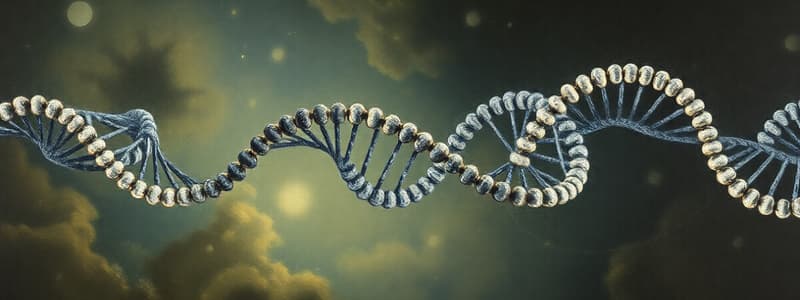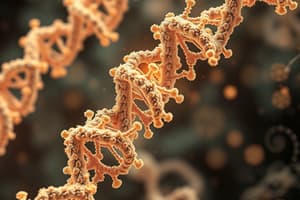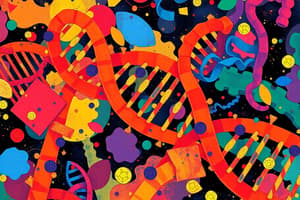Podcast
Questions and Answers
Which phase of the cell cycle does DNA replication occur?
Which phase of the cell cycle does DNA replication occur?
- M phase
- S phase (correct)
- G1 phase
- G2 phase
Telomerase is an enzyme that is only found in healthy cells.
Telomerase is an enzyme that is only found in healthy cells.
False (B)
What is the primary function of DNA replication?
What is the primary function of DNA replication?
to propagate genetic information
Errors in replication can lead to ______, which can have significant consequences for an organism.
Errors in replication can lead to ______, which can have significant consequences for an organism.
Match the following enzymes with their primary role in replication:
Match the following enzymes with their primary role in replication:
What is the primary purpose of replication in biology?
What is the primary purpose of replication in biology?
DNA replication is a conservative process, meaning each new DNA molecule consists solely of newly synthesized DNA strands.
DNA replication is a conservative process, meaning each new DNA molecule consists solely of newly synthesized DNA strands.
What enzyme is crucial for extending the new DNA strands during replication?
What enzyme is crucial for extending the new DNA strands during replication?
In eukaryotes, DNA replication starts at multiple _________ on each chromosome.
In eukaryotes, DNA replication starts at multiple _________ on each chromosome.
Match the following terms with their correct descriptions:
Match the following terms with their correct descriptions:
Which of the following is a key difference between prokaryotic and eukaryotic DNA replication?
Which of the following is a key difference between prokaryotic and eukaryotic DNA replication?
Replication errors are not possible due to the high accuracy of DNA polymerase.
Replication errors are not possible due to the high accuracy of DNA polymerase.
What is the direction of DNA synthesis/elongation?
What is the direction of DNA synthesis/elongation?
Flashcards
Telomerase
Telomerase
An enzyme that maintains telomere length in certain cells.
Importance of Replication
Importance of Replication
Replication is essential for passing genetic information and traits to the next generation.
S phase
S phase
The part of the cell cycle where DNA replication occurs.
RNA Replication
RNA Replication
Signup and view all the flashcards
Replicative Variability
Replicative Variability
Signup and view all the flashcards
Replication
Replication
Signup and view all the flashcards
Semi-conservative Replication
Semi-conservative Replication
Signup and view all the flashcards
Replication in Prokaryotes
Replication in Prokaryotes
Signup and view all the flashcards
Replication in Eukaryotes
Replication in Eukaryotes
Signup and view all the flashcards
Replication Errors
Replication Errors
Signup and view all the flashcards
Study Notes
Definition and Overview
- Replication is the process of creating an identical copy of a biological unit, such as a gene, cell, or organism, essential for growth, repair, and reproduction.
- This process is highly accurate, ensuring the transmission of genetic information from one generation to the next.
- Different biological entities undergo replication via distinct mechanisms.
DNA Replication
- DNA replication is a fundamental process in molecular biology.
- It involves the unwinding and separation of the DNA double helix, with each strand serving as a template to synthesize a complementary strand.
- The process is highly accurate due to proofreading mechanisms.
- Enzymes like DNA polymerase are crucial for DNA replication.
Steps of DNA Replication
- Initiation: Specific proteins bind to the origin of replication and begin unwinding the double helix.
- Elongation: DNA polymerase extends the new strands using the original strand as a template. This proceeds in a 5' to 3' direction.
- Termination: Specific proteins stop replication at the end of the DNA molecule.
Semi-conservative Replication
- DNA replication is semi-conservative.
- Each new DNA molecule consists of one original strand and one newly synthesized strand, ensuring fidelity of genetic information.
Replication in Prokaryotes
- In prokaryotes, DNA replication typically starts at a single origin of replication and proceeds bidirectionally.
- The process is generally faster compared to eukaryotes.
- Prokaryotes utilize a simpler replication machinery.
Replication in Eukaryotes
- Eukaryotic DNA replication is more complex, involving multiple origins of replication on each chromosome.
- This process is slower and more carefully regulated than in prokaryotes to avoid errors.
- Eukaryotic DNA is typically packaged with histone proteins into chromatin, and this packaging needs to be accessible to the replication machinery.
Replication Errors and Repair
- Replication errors can occur, leading to mutations.
- Cells possess repair mechanisms to detect and correct these errors, which are crucial in maintaining genomic stability.
- Errors in DNA replication can have various consequences, ranging from minor to catastrophic.
Telomeres and Replication
- Telomeres are repetitive sequences at the ends of linear eukaryotic chromosomes.
- They protect the chromosome ends from degradation.
- Telomere shortening occurs with each round of replication.
- Some cells, like stem cells and cancer cells, have special enzymes like telomerase to maintain telomere length.
Significance of Replication
- Replication is crucial for the propagation of genetic information and ensures the transmission of traits from one generation to the next.
- Proper replication is vital for cellular growth and development.
- Errors in replication can lead to mutations, which can have significant consequences for the organism.
Other Forms of Replication
- RNA replication also occurs in some biological systems, particularly in viruses.
- This process is similar in principle but uses different enzymes like RNA polymerase.
- Other biological structures, like organelles, might replicate under specialized circumstances.
Replication and Cell Cycle
- Replication occurs during the S phase (synthesis phase) of the cell cycle.
- Precise regulation of replication is essential to ensure correct chromosome duplication before cell division.
- Coordination of replication with other cell cycle events is vital.
Replication and Evolution
- Variations in replication mechanisms can contribute to the diversity of life.
- These variations influence the rate and pattern of mutation accumulation.
- Differences in replication mechanisms are considered a source of evolutionary changes within organisms.
Studying That Suits You
Use AI to generate personalized quizzes and flashcards to suit your learning preferences.




